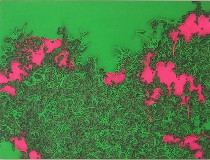 Vox Populi continues to put on shows worth a visit. This time Amy Adams and Max Lawrence have each put up some work that made my eyes and mind jump.
Vox Populi continues to put on shows worth a visit. This time Amy Adams and Max Lawrence have each put up some work that made my eyes and mind jump.
Adams’ paintings of circles on top of circles previously interested me for their profusion and suggestion of infinite mass production (see post). This time, in her show “All We Ever Wanted Was Everything,” Adams has added areas of plain color or loopy strings of color amongst the circles.
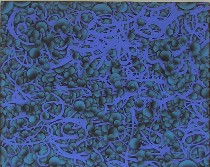 Either way, the new work suggests a tension between the circles and the new stuff, their colors, their shapes, their degree of freedom in mark-making, the implication of victory and subjugation. There’s a struggle between what’s forward and what’s back, mainly because these paintings have no forward no back no space no horizon. It reminds me of looking into the infinity of the computer screen with no there, there. And because the paintings are so immaterial, so smooth and slick in their paint-handling, this fight between marks of paint that don’t exist in a material way really is quite weird and wonderful–and a little bit scary.
Either way, the new work suggests a tension between the circles and the new stuff, their colors, their shapes, their degree of freedom in mark-making, the implication of victory and subjugation. There’s a struggle between what’s forward and what’s back, mainly because these paintings have no forward no back no space no horizon. It reminds me of looking into the infinity of the computer screen with no there, there. And because the paintings are so immaterial, so smooth and slick in their paint-handling, this fight between marks of paint that don’t exist in a material way really is quite weird and wonderful–and a little bit scary.
The circles also make me think of atoms and molecular space and the stringy oobleck in a second color makes me say we’re somewhere in space, in the land of string theory and voids (I’m sure if I understood what string theory really was, I wouldn’t be saying this, but I’m in love with the words).
Finally, what I like about this work is its decorative quality. It’s quite the magic trick–to create something decorative and rather immaterial that talks about a kind of void at the same time as it suggests surfeit and all kinds of other things that have gravitas.
Safety inside, threats outside
While Adams is focused on a threat that’s purely metaphorical and perhaps metaphysical, Lawrence has created an installation which implies a real-world threat that’s also apparently immaterial, or at least hard to understand with its technical wizardry–i.e. just how do radio waves, cell phones, satellites, television, the Internet work?
 Lawrence offers up a living room, with tatty furniture and a plethora of remote controls, with a spy camera and satellites orbiting around the room and telephone poles. The suggestion of governmental control of media, of spying via satellite, of invasion of our homes via inexplicable technology comes through, but I can’t say I thought the installation was a complete success; it doesn’t achieve a sense of physical immersion that gives installation art its kick. But the ideas there are rich and still worth exploring.
Lawrence offers up a living room, with tatty furniture and a plethora of remote controls, with a spy camera and satellites orbiting around the room and telephone poles. The suggestion of governmental control of media, of spying via satellite, of invasion of our homes via inexplicable technology comes through, but I can’t say I thought the installation was a complete success; it doesn’t achieve a sense of physical immersion that gives installation art its kick. But the ideas there are rich and still worth exploring.
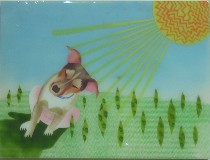 The paintings, however, are beautiful and pretty much on the same themes. Lawrence is using shiny resin to encase his paintings, and like Alyson Shotz (see Shotz post) he is painting on the layers of resin to build up pattern and image. He’s blowing up Persian miniature motifs and original plaids and suggesting space with patterns.
The paintings, however, are beautiful and pretty much on the same themes. Lawrence is using shiny resin to encase his paintings, and like Alyson Shotz (see Shotz post) he is painting on the layers of resin to build up pattern and image. He’s blowing up Persian miniature motifs and original plaids and suggesting space with patterns.
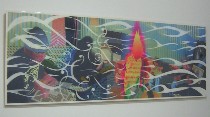 He’s making portraits of his friends, his girlfriend, his dog and himself (left above and right above). He’s preserving them and the atmosphere of love and friendship in resin. The sun shines through his dog’s ears.
He’s making portraits of his friends, his girlfriend, his dog and himself (left above and right above). He’s preserving them and the atmosphere of love and friendship in resin. The sun shines through his dog’s ears.
He puts two tough-looking hookers in front of brown and yellow stripes, a claustrophobic choice that implies a lack of horizon in their lives. He arranges his friends in hoodies in a room, hanging out, white curls like smoke obscuring the space and pulling it together at the same time (left).
It’s for these paintings that Lawrence’s show is a must see, along with Adams’.
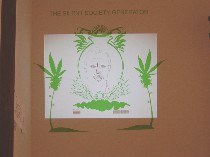 There’s also a randomly tacked on but charming wall painting of marijuana palms surrounding a dollar-billish portrait oval on which a computer projects portraits of criminals that Lawrence drew, mixing and matching the facial features. You can generate these new faces with the computer in the room and print them out to take home (right, “The Silent Society Generation”).
There’s also a randomly tacked on but charming wall painting of marijuana palms surrounding a dollar-billish portrait oval on which a computer projects portraits of criminals that Lawrence drew, mixing and matching the facial features. You can generate these new faces with the computer in the room and print them out to take home (right, “The Silent Society Generation”). 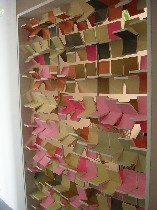 This high-tech wonder is in sharp contrast to the unapologetically low-tech approach to the rest of the installation, which includes a surveillance camera painted on the wall, satellites painted on the walls and on the television screen, and funniest but least comprehensible of all, a room divider of pinwheels of skin colors that struggle to rotate with the help of a bank of fans (left). I don’t get it but it made me laugh out loud.
This high-tech wonder is in sharp contrast to the unapologetically low-tech approach to the rest of the installation, which includes a surveillance camera painted on the wall, satellites painted on the walls and on the television screen, and funniest but least comprehensible of all, a room divider of pinwheels of skin colors that struggle to rotate with the help of a bank of fans (left). I don’t get it but it made me laugh out loud.
Also showing at Vox is a video, “Dallas,” by Sheena Macrae (I really couldn’t see it with the reflections on the screen. This is not usually a problem there, so I’m not sure why it was happening yesterday–low winter light?). Apparently it’s layers of images from the TV show Dallas. I can’t really give it a fair report, but Roberta said she’d have something to say about it, upcoming.
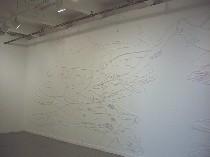 In the back room is an installation by Danica Maier. Maier, who travelled from London to do this installation, uses lace to create a multi-layered sexy drawing on the walls.
In the back room is an installation by Danica Maier. Maier, who travelled from London to do this installation, uses lace to create a multi-layered sexy drawing on the walls.
The material, lace is so full of implications. It’s peek-a-boo and it’s modest. It’s rich and it’s low-class. It’s public in windows even while it serves a purpose of privacy, and it’s private in underwear even though it serves a purpose of revealing. It’s old-fashioned, and it’s old, some of it from Maier’s grandmother. The fasteners–straight pins–here give new meaning to the word pin-ups.
The lace and the fasteners together communicate a fragility and temporariness that seem appropriate and inappropriate, depending on whether you’re thinking about your last failed love affair or the love of your life who’s still the love of your life–or even if you’re thinking about how love is an eternal verity.
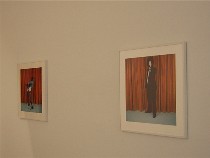
The subject matter, while old as Adam and Eve, has a modern shamelessness (what would her grandmother think?). The lace is pinned to the wall where it casts shadows, but visually it is a little subtle–but there’s some fun in decoding what you’re looking at.
There was also a small show of photographs by John Lorenzini.









